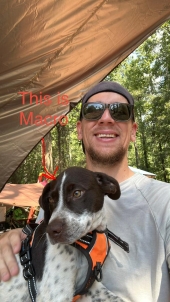












































In my dreams! Apparently there are people here who have what locally referred to as "Japanese timber bamboo", but we're waaayyy... warmer than you guys.My ideal would be giant timber running bamboo, but I'll settle for anything that won't die!
Visit Redhawk's soil series: https://permies.com/wiki/redhawk-soil
How permies.com works: https://permies.com/wiki/34193/permies-works-links-threads
 1
1




Permaculture...picking the lock back to Eden since 1978.
Pics of my Forest Garden
 1
1




“It’s said war—war never changes. Men do, through the roads they walk. And this road—has reached its end.”
 1
1




There are some clumping bamboos that are leaf hardy to -20F, but they are shade lovers and are sensitive to heat, so they would not survive due to the direct sun and summer heat. The cold hardy running bamboos are only leaf hardy down to -10F, but their roots are actually tougher and more cold hardy than the roots of the clumping types. These are my recommendations:
Phyllostachys bissetii - This species seems to be the toughest and most cold hardy, and it has foliage branching almost all the way down to the ground.
Phyllostachys aureosulcata and ‘Spectabilis’ variety
Phyllostachys nuda
Phyllostachys atrovaginata - This species has the strongest wood, but foliage doesn't begin until 5-6' up.
Phyllostachys parvifolia
In order to estimate the maximum mature height in your location, I would subtract about 10 feet from the indicated height for each of these. Please note, if you do get more than one species, we do not recommend planting them together. We suggest keeping them separated by rhizome barrier or a pruning trench if they are going in the same area.
For cold climates, I do advise starting with a #5 size if possible. The #5 size (average height 4-6') is $95 per plant for each of the above except for the parvifolia, which is $120 per plant. The #5 size ships for $20 per plant. You could only get a couple of #5 size plants and stay under $250. You are welcome to try them in smaller sizes if you want to experiment, but a #5 has a better chance of making it the first winter.











 2
2




“It’s said war—war never changes. Men do, through the roads they walk. And this road—has reached its end.”
 1
1


















Permaculture...picking the lock back to Eden since 1978.
Pics of my Forest Garden














 2
2




Permaculture...picking the lock back to Eden since 1978.
Pics of my Forest Garden

 5
5




“It’s said war—war never changes. Men do, through the roads they walk. And this road—has reached its end.”
 4
4




Phyllostachys bissetii - This species seems to be the toughest and most cold hardy, and it has foliage branching almost all the way down to the ground.
Phyllostachys aureosulcata and ‘Spectabilis’ variety
Phyllostachys nuda
Phyllostachys atrovaginata - This species has the strongest wood, but foliage doesn't begin until 5-6' up.
Phyllostachys parvifolia
nuda was a total bust here in zone 4b/5a. I heard the same thing from a fellow in Niagara, not that it failed, just that it was like having 'running sticks' as opposed to bamboo. I can't list all of the plants that have failed here, but a list would include: P. vivax, rubromarginata, F. murieale (could try again), P. bissetti, P. aureosulcata 'aureocaulis', and about 15 other Phyllostachys that I can't remember right now! Outside of zone 6, and even in zone 6, plants need some serious size to have a chance of making it long term (i.e. larger than 7 gallon sized). I imagine that I'd still have lots of different species if I had listened to that advice when I first started with bamboo!
The ones that are succeeding are:
P. aureosulcata, probably averages 15' or so. Usually mostly top-kills here, shoots in May.
P. aureosulcata 'spectibilis': Seems to downsizing here, probably no taller than 10'. Not as vigorous as the species.
P. aureosulcata 'alata': Running like a champ. Has spread very quickly, but is still really short at (perhaps) 6'. I keep hoping for an upsize.
 4
4





 2
2




Our average winter temps "claim" +2C, however we've got a weather system moderated by the Pacific El Nino and La Nina superimposed on even bigger fluctuations from other systems whose names I've forgotten. What that means, is that my P. dulcis which has been growing well for over a decade, has had years when it seemed to put up plenty of new culms, and last year, when there were surprisingly few. Last year we had some periods of below 0C weather, and have again this year.Kārlis Taurenis wrote:
Cold hardy bamboos - a really important topic for all of us living in colder climates, and I intend to write a proper article about it on my website soon!
The Phyllostachys (classic, big, spreading bamboos) species that Jennifer mentioned are the usual suspects for cold climates:
Visit Redhawk's soil series: https://permies.com/wiki/redhawk-soil
How permies.com works: https://permies.com/wiki/34193/permies-works-links-threads
 2
2








 3
3





|
catch it before it slithers away! Oh wait, it's a tiny ad:
Homestead Pigs Course
https://permies.com/wiki/365748/Homestead-Pigs
|




